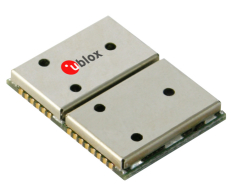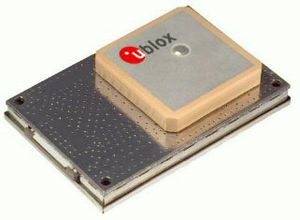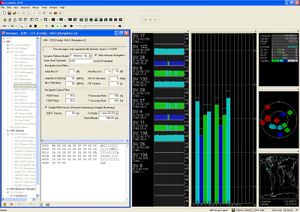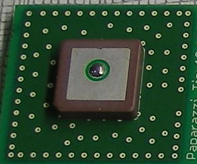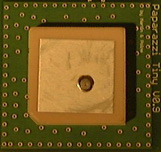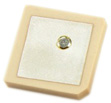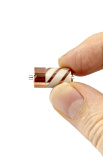Sensors/GPS
Paparazzi autopilots are designed around the popular u-blox brand of receivers due to their small size, excellent performance, and 4Hz position update rate. The Tiny features an onboard LEA series receiver, while Classix and AVR-based boards require an external receiver such as the SAM-LS. Receivers must be configured prior to use with the autopilot as indicated below. The proprietary UBX protocol is used as it offers more information and efficiency than the universal NMEA protocol. The protocol is parsed in sw/airborne/gps_ubx.c. Other GPS brands would require a similar parsing file to be written for NMEA or other proprietary protocols.
GPS Receivers
u-Blox LEA Series
The Tiny currently uses the u-blox LEA-4P featuring Antaris-4 technology and uses uBlox's more efficient UBX binary protocol. This module is a surface mount package which is soldered directly onto the target board (Tiny in this case). The Tiny also features a battery backup (capacitor) that allows the GPS to retain data while powered off for significantly faster signal re-aquisition.
Paparazzi Stand-alone GPS Receivers
There are currently two LEA-based stand-alone GPS receiver/antenna prototype boards in development, one based on the Sangshin 13mm patch antenna and another based on the Sarantel helix antenna. Drawings are available from the CVS
u-Blox SAM-LS GPS Smart Antenna
The other boards use a stand alone module from u-blox called the SAM-LS. It is an integrated TIM-LP module with a ceramic patch antenna. This processor also runs on 4hz and must be configured to use the UBX protocol. Both modules have proven reliable and robust. With battery backup (3V watch battery) they show hot starts of around a couple seconds. The LEA-LA processor weighs a couple grams and the complete the SAM-LS module with antenna and shielding weighs about 20grams.
- Note: Effective 12/2006 u-blox has begun to phase out the SAM-LS product. No replacement has been announced.
Sourcing from u-blox
uBlox keeps tight control over the distribution of their products. They must be obtained DIRECTLY from their own reseller offices. These offices may not be available in your area, for example Canada does not have a reseller. Sample quantities can be obtained from uBlox but overnight or 2 day shipping is required which drives the cost up considerably. While it is a large hassle obtaining these devices, it is undoubtedly worth it.
GPS & Control Boards
Tiny AP
This board is designed to have both the GPS receiver and antenna soldered directly to it. The LEA-LA, LEA-4P, and LEA-4H receivers have all been used with great success though any receiver from the LEA series should work. Keep in mind that if you are not using a GPS model with flash (LEA-4A) you will need to configure the AP to send boot commands to the GPS on start up. The programmable models include Flash EEPROM internally and save their configurations indefinitely.
Classix, 1.2.1 AVR, Lite, and RoboStix AP
These boards are configured to connect to an externally mounted u-blox module such as the Paparazzi stand-alone receivers or the commercially available but obsolete SAM-LS. The u-blox receivers require 3.3v power and all current models have 5V tolerant data lines. The best way to connect to the SAM-LS is to remove the bottom case and solder the 4 wires directly to the TIM-LL module (GND (pin 1) ,VCC (pin 2),TX (Pin 5),RX (pin 4)) check the TIM-LL datasheet for pinout diagrams. The Classix and Lite boards feature a 3.3V regulator to power the GPS.
GPS configuration using U-Center
U-Center is a very comprehensive Windows freeware program intended for the configuration and evaluation of u-blox receivers.
- Download u-center (password protected download, use paparazzi for username & password)
- Note: You must install the UART tunnel to enable direct access to the built-in GPS on the Tiny.
The u-blox and Tiny UARTs both operate at 3.3V TTL levels and are 5V TTL tolerant. You must use a level shifter such as the common MAX232 to connect these devices to a standard PC serial port. The easiest and most recommended method is to connect to a USB port instead of serial with the $20 FTDI USB-TTL converter cable available from Digikey, Mouser, or direct from FTDI. Other similar converters are available from pololu or sparkfun. A stand-alone GPS such as the SAM-LS will require clean 3.3V/50mA power and a common ground with the TTL converter.
- U-blox occasionally releases firmware updates. Log on to the u-blox website using paparazzi for username & password to view or download the latest firmware images. There have 'never' been any updates released for the Antaris-4 series used in the Tiny.
Start U-center and choose your com port from the pull down list under the connect button near the top left corner of the window. Choose your baudrate from the pull down box to the right of the connect button or select the auto-baud button to the right of that. U-blox default is 9600 baud. This must be changed to 19200 or higher to accomodate the 4Hz update rate.
![]()
Uploading the Configuration File
Download the appropriate configuration file below and use u-center to load in onto your receiver. Under the Tools menu, choose GPS configuration. Be sure the box 'Store configuration into BBR/Flash' is checked and hit the button File>>GPS. A few errors and retries are normal, but a significant number of errors may indicate a poor connection and the software will notify you if it is unable to send all the data successfully.
Manual Configuration
If you prefer to setup your receiver manually or have a model not listed above, here are instructions to configure your receiver in u-center. Open the message window (menu View->messages view) to start the configuration process by changing the following settings:
1. Right Click on the NMEA Icon and choose disable child 2. Choose UBX->CFG->NAV2(Navigation 2) - set it to use Airborne 4G (tells the Kalman filter to expect significant changes in direction) 3. UBX->CFG->PRT - set USART1 to 19200bps (must match the value in your Airframe file) 4. Change the baudrate of U-Center to 19200bps if the connection is lost at this point 5. UBX->CFG->RATE(Rates) - change GPS Mode to 3 - Auto (Enabling faster bootup only if signal levels are very good) 6. UBX->CFG->RXM(Receiver Manager) - change the Measurement Period to 250ms (4 Hz position updates) 7. UBX->CFG->SBAS : Disable (SBAS appears to cause occasional severe altitude calcuation errors) 8. UBX->NAV (not UBX->CFG->NAV): double click on POSUTM, SOL, STATUS, SVINFO, VELNED. They should change from grey to black 9. UBX->CFG->CFG : save current config, click "send" in the lower left corner to permanently save these settings to the receiver
- Cycle the power and verify that the new configuration was saved
- To reset the receiver to the factory defaults go to UBX->CFG->CFG, select 'Revert to default configuration', and click Send at the bottom left corner. To permanently save these values choose 'Save current configuration' and click Send.
- To backup the configuration to a file on your PC: under the tools menu, choose GPS configuration, then click GPS>>file. This file can be re-loaded in a similar manner to configure additional identical receivers. Be sure the box 'Store configuration into BBR/Flash' is checked when reloading a configuration file to make the changes permanent.
DGPS (Differential GPS)
Differential GPS is any method of improving GPS accuracy by comparing the GPS-indicated position of a nearby location to the known value and transmitting any error to the mobile unit. DGPS was originally created as a means of bypassing the deliberately introduced inaccuracies in civilian GPS signals. The original method used low frequency ground radios to relay correction data to the mobile unit and is still used today at airports, shipping ports, and even individual farms. Satellite Based Augmentation System (SBAS) is a modern form of DGPS where the ground stations relay correction data to a GEO-Stationary satellite, which then relays it to the mobile unit on standard GPS frequencies eliminating the need for a separate radio reciever. SBAS is currently available in 3 regions, WAAS, EGNOS, and MSAS though only WAAS is officially operational. U-blox receivers support all common varieties of DGPS read the u-blox SBAS application note.
- It is important to note that DGPS methods only improve the accuracy of the position calculation, not the precision. Since Paparazzi navigation is typically performed relative to the power-on location, any static error that could be corrected with DGPS is irrelevant.
WAAS issues
WAAS has been officially operational and "suitable for safety-of-life applications" since 2003. The default setting of all u-blox receivers ignores WAAS correction data and only uses the WAAS satellites for regular navigation like any other satellite. U-blox recommends further limiting this setting to exclude any stray EGNOS/MSAS satellites in North America, and completely disabling all SBAS functions for use outside North America.
EGNOS issues
EGNOS is officially in "testing mode" and no claims of reliability are made. The u-blox FAQ states the following:
- "Do you see issues with EGNOS?"
- "Yes. Although the data transmitted by the EGNOS satellites are usually good and valuable (e.g. during the solar storms in autumn 2003), they can sometimes be very unreliable, for example when system tests are performed. As an example, u-blox has noticed erroneous range information (up to three hundred kilometers) on various EGNOS satellite over the last few months [2006]."
Further Reading
The u-blox System Integration Manual covers a lot of GPS theory as well as product specific topics.
Antennas
Sangshin 13mm Patch
Part of interest: KSA-ST1580MS13
The Tiny 0.99 (not 0.9) and 1.1 were designed for this antenna however this part has not been verified for best performance yet.
Size: 13 x 13 mm
Center Frequency: 1580 MHz
Bandwidth: 5 MHz
@Fo: -15 dB
GAIN (dBi): 0 dBi
Ground Plane: 50 x 50 mm
Available From
Systronic INC. - Alberta, Canada
20mm Unknown Salvage Patch
Reportedly the best match for the Tiny 0.9 through 1.1. No source for this antenna has been found yet.
Availability
These antennas were salvaged from a batch of otherwise defective GPS/GSM car antennas. Availability is very limited. Manufacturing trends appear to be moving away from 20mm antennas and toward 18mm.
EMTAC 18mm
The part number for the 1580MHz 18x18mm is ANA1580T18D40 and is not listed on their website.
Availability
Direct from TransplantGPS in MN, USA. The antennas should be in stock at a cost of $3.55ea but they may want you to order > $50 USD per order.
Sangshin 18mm Patch
Sangshin antennas are available from rfmw
Sarantel GeoHelix-P2
GeoHelix-P2 Passive GPS Antenna [datasheet]
This antenna apparently works great with the u-blox series GPS receivers so is not tied to any version of the board. It does not mount directly to the board. Impedence is 50ohm so almost any radio coax will work. Remember the antenna is passive with no RF amplification done at the antenna so every inch of extra coax introduces loss. Adding a ground plane (tin foil even) near the base of the antenna with a target size of 50mm x 50mm should also increase the performance.
Availability
Direct from Sarantel @ cost of approx $18 USD each
